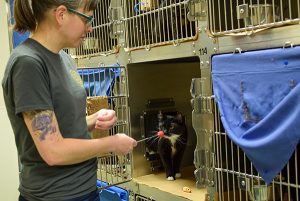How OHS’ Cat Behavior Modification Program saves feline lives
Can you really train a cat? This is a common question from most people who hear about the Behavior Modification Program, or BMOD, program for cats. While most cats who come to OHS are able to adjust to shelter life, those who come from challenging circumstances sometimes need extra help to prepare for life in a new home.
Some may spend days hiding in the back of their kennel, trying to disappear. Others may lash out, hiss or scratch. In both instances, fear is at the heart of their behavior challenges.
OHS’ Cat Behavior Modification Program was developed to help rehabilitate fearful cats, teaching them how to trust people and prepare them for life in a home. Cats in the BMOD program are housed in a quiet room, called Whisker Way, with a dedicated behavior expert who provides daily care, enrichment and training for the cats.
Each cat receives a customized training plan. Cats who have a history of swatting at people may learn how to sit for a treat or touch a target with their nose. Cats who are worried about being picked up might learn how to run into a crate on cue, making trips to the vet easier.
Through reward-based training and interactive play therapy, cats in the program move from hiding and hissing to soliciting pets and attention.
Since formalizing OHS’ BMOD program for cats in 2015, 213 cats have been placed in the program and 97 percent have been adopted. There are up to nine cats in the program at any given time and most are between one and four years of age.
While there is no time limit on how long cats can stay in the program, most typically progress within three to eight weeks and find a loving home two to three weeks after “graduating” from the program.
A Day in Whisker Way
What does a day teaching cats look like? Megan Willard, OHS cat behavior expert, takes you inside a day in Whisker Way with cats in the BMOD program.
8:30 a.m.
Cleaning and feeding breakfast
9:30 a.m.
Let the learning begin! Enrichment toys like stuffed cardboard tubes with catnip and treats help engage the cats’ minds. They love to rip up the cardboard to get to the treats and catnip.
10:30 a.m.
Megan gives the cats time out of their kennel, if/when they are ready. The behavior room, or Whisker Way, has shelves, cat trees, toys and tablets for watching bird videos. Yes, cats love watching bird videos!
11:30 a.m.
Time to meet new students. The Admissions Team lets Megan know about any new cats who are having a hard time adjusting. Megan reviews the cat’s history, does an assessment and develops a plan.
12:30 p.m.
Lunchtime in Whisker Way!
1:30 p.m.
The Behavior Team meets to review plans and success stories.
2:30 p.m.
BMOD graduates meet with potential adopters. Even when it’s not a good fit, it’s still great practice for the cats.
3:30 p.m.
Interactive playtime with cats who have become friends during their time at OHS. Even though the cats are comfortable with each other, Megan uses this playtime to help the cats feel safe around people.
4:30 p.m.
Dinner time!
5:30 p.m.
Wrap up the day and get ready for tomorrow.
Have a question about your cat’s behavior?
Oregon Humane Society is here to help! We offer a free pet behavior help line at (503) 416-2983, a comprehensive online resource library, and one-on-one appointments. Learn more about our cat training services.








